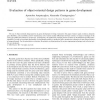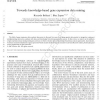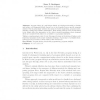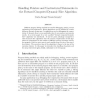761 search results - page 96 / 153 » Reverse engineering MAC |
JPDC
2006
13 years 8 months ago
2006
We introduce Virtual Leashing,1 a new technique for software protection and control. The leashing process removes small fragments of code, pervasive throughout the application, an...
INFSOF
2007
13 years 8 months ago
2007
The use of object-oriented design patterns in game development is being evaluated in this paper. Games’ quick evolution, demands great flexibility, code reusability and low mai...
JBI
2007
13 years 8 months ago
2007
ct 10 The field of gene expression data analysis has grown in the past few years from being purely data-centric to integrative, aiming at 11 complementing microarray analysis with...
JUCS
2007
13 years 8 months ago
2007
: Program slicing is a well known family of techniques intended to identify and isolate code fragments which depend on, or are depended upon, specific program entities. This is pa...
ACTAC
2002
13 years 8 months ago
2002
Different program slicing methods are used for debugging, testing, reverse engineering and maintenance. Slicing algorithms can be classified as a static slicing or dynamic slicing...




